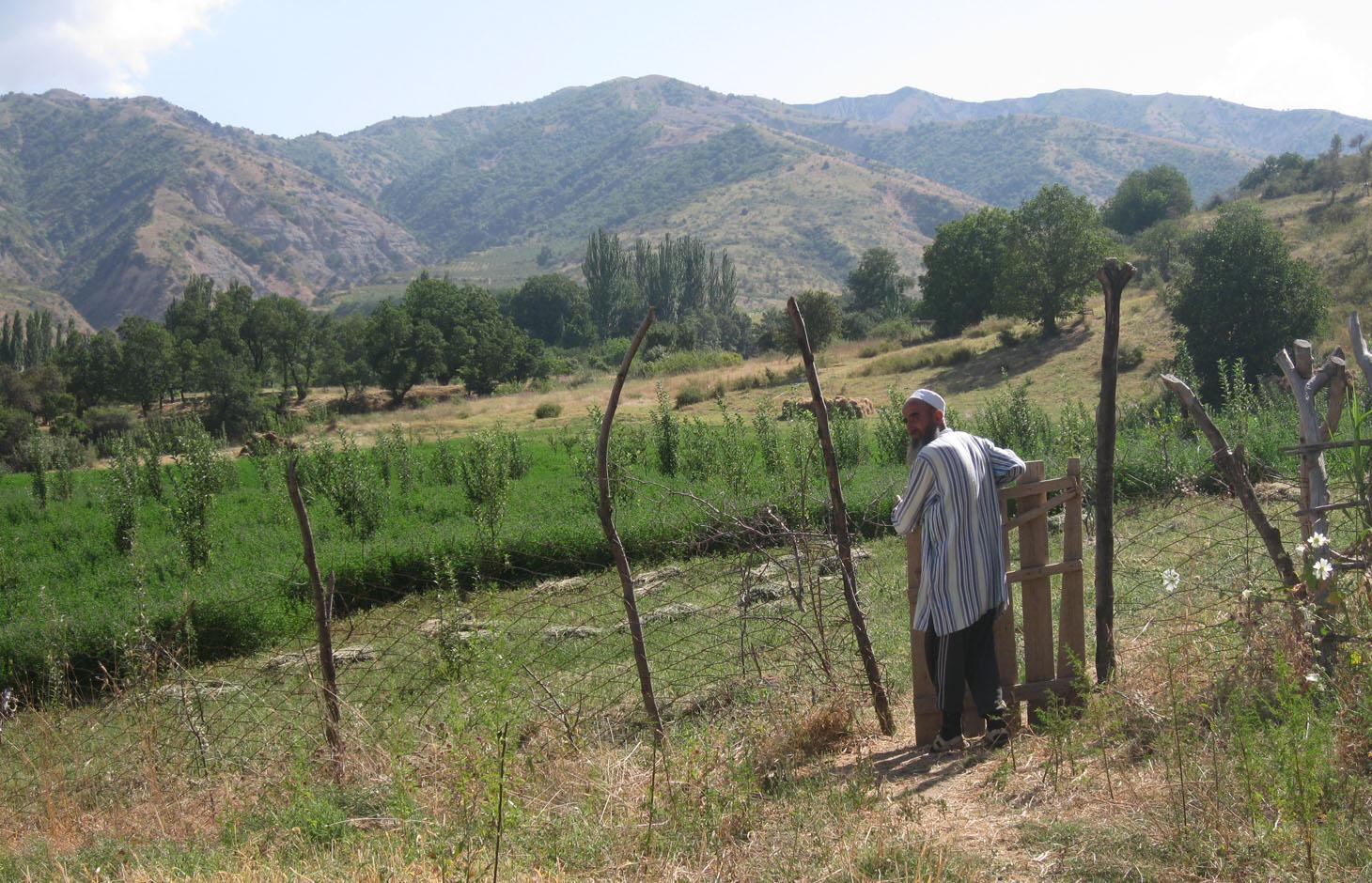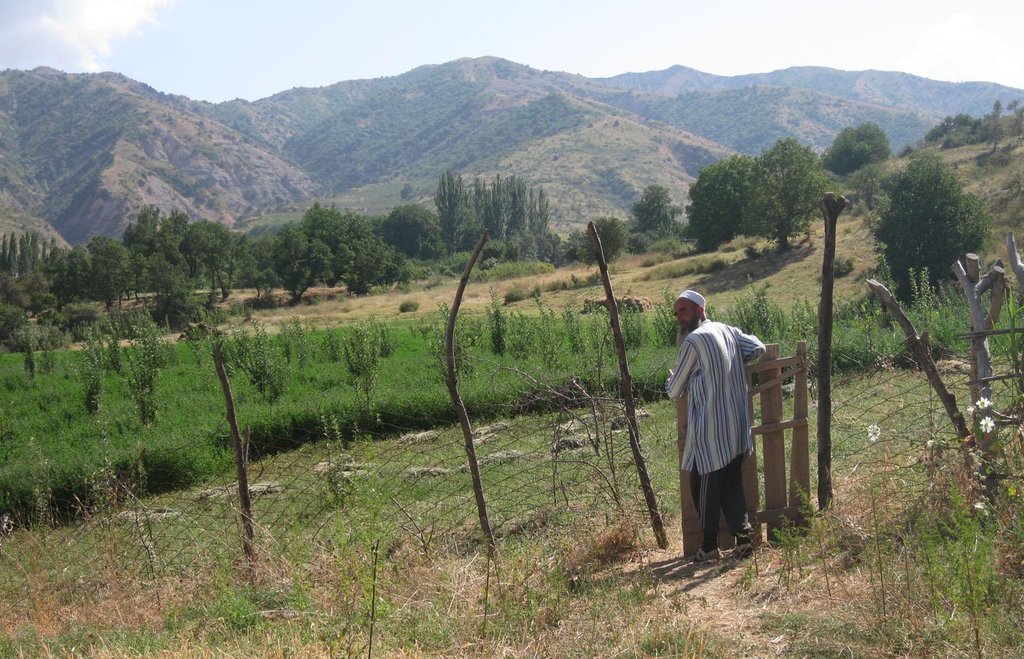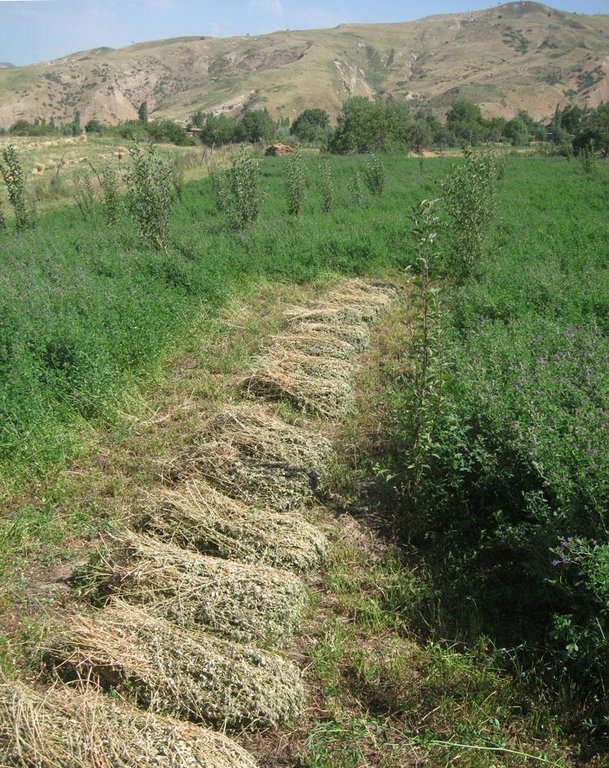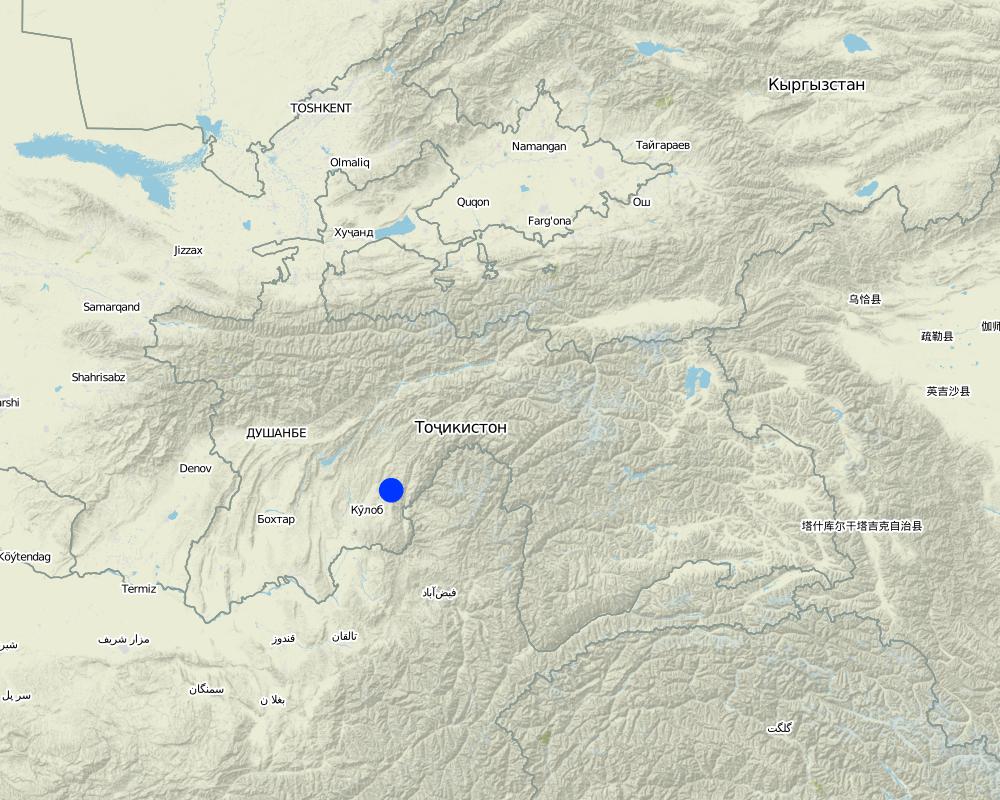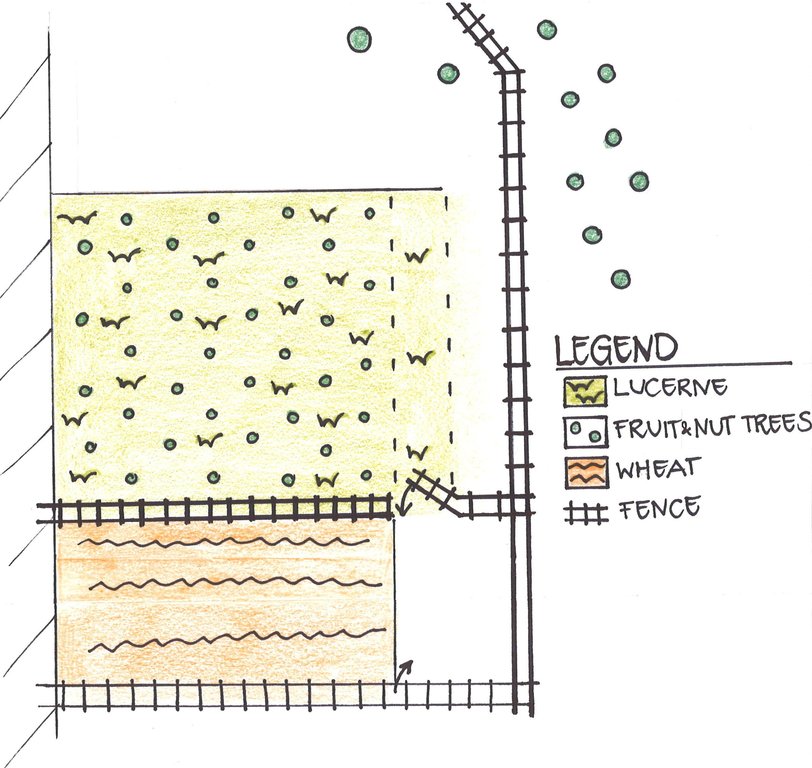Orchard establishment on a former wheat plot, by planting fruit tree seedlings in combination with sowing Alfalfa [塔吉克斯坦]
- 创建:
- 更新:
- 编制者: Malgorzata Conder
- 编辑者: –
- 审查者: David Streiff, Alexandra Gavilano
technologies_1138 - 塔吉克斯坦
查看章节
全部展开 全部收起1. 一般信息
1.2 参与该技术评估和文件编制的资源人员和机构的联系方式
SLM专业人员:
有助于对技术进行记录/评估的机构名称(如相关)
CDE Centre for Development and Environment (CDE Centre for Development and Environment) - 瑞士有助于对技术进行记录/评估的机构名称(如相关)
NCCR North-South (NCCR North-South) - 吉尔吉斯斯坦有助于对技术进行记录/评估的机构名称(如相关)
CARITAS (Switzerland) - 瑞士1.3 关于使用通过WOCAT记录的数据的条件
编制者和关键资源人员接受有关使用通过WOCAT记录数据的条件。:
是
2. SLM技术的说明
2.1 技术简介
技术定义:
Conversion of wheat monocropping into an Alfalfa plot with the aim to establish an orchard
2.2 技术的详细说明
说明:
In 2009 the farmer changed his wheat plot into an Alfalfa plot where he also planted fruit tree seedlings in between to establish an orchard. One hectare is used for the perennial cropping of Alfalfa. Alfalfa cropping supplements beneficial soil functions which are crucial for the establishment of an orchard. The plot lies on a narrow plateau next to other wheat crops. The plot is mainly bordered by fruit and nut orchards on a gentle slope, and by a steep slope of the riverbed. A solid fence prevents boars from entering the area through the nut orchard. The plot is not accessible by the steep slope. Two fences are built from the side of the neighboring wheat plots. One fence works like an entrance gate to all the plots on that plateau. A second fence indicates the boundaries between the farmers' Alfalfa crop and the wheat plots belonging to other farmers. The whole family is working on the farm land, consisting of several plots which are distributed over the valley. The children are mainly guarding the cropland.
Purpose of the Technology: In order to establish an orchard, first the farmer planted Alfalfa, which maintains more moisture in the soil and hence creates favorable conditions for tree growth. The wheat cropping was drying out the soil. Therefore during heavy rainfall events water infiltration was limited, and the strong runoff washed away the wheat crop. It was the farmer’s initiative to change the crop management, but Caritas Switzerland supported him with a financial grant. Alfalfa can be harvested several times a year, which he can use as fodder for the livestock or as cash crop.
Establishment / maintenance activities and inputs: The first year after the crop rotation there was no benefit, as the Alfalfa did not give any harvest yet. According to the farmer, Alfalfa seeds were relatively cheap (15 TJS per kg) and result in a good harvest. Currently he is harvesting Alfalfa three times a year, wheat could only be harvested once a year. The whole family was involved in the establishment of the alfalfa crop and tree planting, by ploughing, sawing Alfalfa, planting the seedlings and constructing the fence. Despite the fence, the crop is often guarded by the farmer or his children because boars enter his property. After the first year some seedlings dried out which he had to replace. Presently, little maintenance is required, only guarding and cutting Alfalfa.
Natural / human environment: The farmer’s plot is situated on a plateau on the other side of the riverbed, from where the village of Momandion is located. It takes some 15 minutes to get from their house to the plot. One of his neighbors adopted the technology of sowing Alfalfa and planting fruit tree seedlings.
2.3 技术照片
2.5 已应用该技术的、本评估所涵盖的国家/地区/地点
国家:
塔吉克斯坦
区域/州/省:
Khatlon, Tajikistan
有关地点的进一步说明:
Muminabad
具体说明该技术的分布:
- 均匀地分布在一个区域
如果不知道精确的区域,请注明大致覆盖的区域:
- < 0.1 平方千米(10 公顷)
注释:
Total area covered by the SLM Technology is 0.01 km2.
Total crop size is around 1.5 ha, lucerne crop is around 1 ha. The remaining area is a small wheat plot and meadow with some sparse walnut trees. A fruit and nut tree orchard is above the fenced crop.
Map
×2.6 实施日期
如果不知道确切的年份,请说明大概的日期:
- 不到10年前(最近)
2.7 技术介绍
详细说明该技术是如何引入的:
- 通过土地使用者的创新
注释(项目类型等):
Farmers idea, one third was payed by himself, the rest was supported by Caritas
3. SLM技术的分类
3.1 该技术的主要目的
- 改良生产
3.2 应用该技术的当前土地利用类型

农田
- 一年一作
- 乔木与灌木的种植
年作 - 具体指明作物:
- 饲料作物 - 苜蓿
乔木和灌木种植 - 指定作物:
- 水果、其他
每年的生长季节数:
- 1
具体说明:
Longest growing period in days: 180Longest growing period from month to month: April-Sept/Oct
注释:
Major land use problems (compiler’s opinion): Soil erosion, poor nutrient and moisture availability in the soil, high runoff
Major land use problems (land users’ perception): Soil erosion, poor soil moisture availability, high runoff, declining yields
Future (final) land use (after implementation of SLM Technology): Mixed: Mf: Agroforestry
Type of cropping system and major crops comments: Fruits of growing orchard will be food and probably cash crop in future
3.3 由于技术的实施,土地使用是否发生了变化?
注释:
Cropland: Ca: Annual cropping
3.4 供水
该技术所应用土地的供水:
- 雨养
3.5 该技术所属的SLM组
- 改良植物品种/动物品种
3.6 包含该技术的可持续土地管理措施

农艺措施
- A1:植被和土壤覆盖层
- A2:有机质/土壤肥力

植物措施
- V2:草和多年生草本植物

管理措施
- M1:改变土地使用类型
注释:
Main measures: management measures
Secondary measures: agronomic measures
Type of agronomic measures: cover cropping
Type of vegetative measures: aligned: -contour
3.7 该技术强调的主要土地退化类型

土壤水蚀
- Wt:表土流失/地表侵蚀
- Wo:场外劣化效应

化学性土壤退化
- Cn:肥力下降和有机质含量下降(非侵蚀所致)

物理性土壤退化
- Pk:熟化和结壳
- Pi:覆土

生物性退化
- Bc:植被覆盖的减少
注释:
Main type of degradation addressed: Wo: offsite degradation effects, Bc: reduction of vegetation cover
Secondary types of degradation addressed: Wt: loss of topsoil / surface erosion, Cn: fertility decline and reduced organic matter content, Pk: sealing and crusting
Main causes of degradation: crop management (annual, perennial, tree/shrub), poverty / wealth (Fear of food insecurity pushed farmer to plant wheat, year by year)
Secondary causes of degradation: education, access to knowledge and support services (No knowledge about alternative and beneficial land management)
3.8 防止、减少或恢复土地退化
具体数量名该技术与土地退化有关的目标:
- 修复/恢复严重退化的土地
注释:
Main goals: rehabilitation / reclamation of denuded land
4. 技术规范、实施活动、投入和成本
4.1 该技术的技术图纸
技术规范(与技术图纸相关):
The farmer’s property is located on a plateau, surrounded by an upper orchard on a slope (in the top right corner on the figure) and delimited by a steep embankment (on the left on the figure). The Lucerne plot is protected by a fence and the embankment to hinder intrusions of boars. There is a well locked entrance to get to the crop. A second fence protects the adjacent wheat crops and the Lucerne plot. Around 600 fruit trees are planted in the crop leaving a buffer strip of Lucerne.
Location: Momandion, Obishur watershed. Muminabad, Kathlon, Tajikistan
Technical knowledge required for field staff / advisors: moderate
Technical knowledge required for land users: moderate
Main technical functions: improvement of ground cover, increase in organic matter, increase in nutrient availability (supply, recycling,…), increase / maintain water stored in soil, spatial arrangement and diversification of land use
Secondary technical functions: control of dispersed runoff: retain / trap, control of concentrated runoff: retain / trap, improvement of surface structure (crusting, sealing), improvement of topsoil structure (compaction), increase of infiltration
Cover cropping
Material/ species: Alfalfa to recover soil for orchard
Aligned: -contour
Number of plants per (ha): 400
Vertical interval between rows / strips / blocks (m): 3
Vertical interval within rows / strips / blocks (m): 2
Change of land use type: Conversion from wheat to fenced Alfalfa crop and orchard
Alfalfa crop has a twofold function, as a crop which is harvested several times a year and as cover crop to reestablish soil properties
作者:
Malgorzata Conder
4.2 有关投入和成本计算的一般信息
具体说明成本计算所用货币:
- 美元
注明雇用劳工的每日平均工资成本:
12.40
4.3 技术建立活动
| 活动 | 时间(季度) | |
|---|---|---|
| 1. | Buying and planting 600 trees: 10 Min/ tree for digging | once |
| 2. | After first year: 100 trees dried out | once |
| 3. | Fencing 400 m, by 6-7 pers, 10-11 days (8 h a day) | once (spring) |
4.4 技术建立所需要的费用和投入
| 对投入进行具体说明 | 单位 | 数量 | 单位成本 | 每项投入的总成本 | 土地使用者承担的成本% | |
|---|---|---|---|---|---|---|
| 劳动力 | Planting trees | Persons/day | 12.5 | 12.4 | 155.0 | 37.0 |
| 劳动力 | Planting trees for replacment | Persons/day | 2.1 | 12.4 | 26.04 | 100.0 |
| 劳动力 | Plowing labour | Persons/day | 1.0 | 12.4 | 12.4 | |
| 劳动力 | Sowing | Persons/day | 0.27 | 12.4 | 3.35 | |
| 设备 | Plowing machine | days | 1.0 | 103.5 | 103.5 | 37.0 |
| 设备 | Petrol | litres | 120.0 | 1.1383333 | 136.6 | 37.0 |
| 植物材料 | Buying trees | trees | 600.0 | 0.62116666 | 372.7 | 37.0 |
| 植物材料 | Buying tree replacments | trees | 100.0 | 1.035 | 103.5 | 100.0 |
| 植物材料 | Seeds | kg | 20.0 | 3.1 | 62.0 | 37.0 |
| 施工材料 | Fence | area | 1.0 | 1490.7 | 1490.7 | 37.0 |
| 技术建立所需总成本 | 2465.79 | |||||
| 技术建立总成本,美元 | 2465.79 | |||||
如果土地使用者负担的费用少于100%,请注明由谁负担其余费用:
Caritas
注释:
Duration of establishment phase: 1 month(s)
4.5 维护/经常性活动
| 活动 | 时间/频率 | |
|---|---|---|
| 1. | Harvesting/Cutting Alfalfa 3 times and seeds 1 time, 8 Pers one week (first cut) | 4 times a year |
| 2. | Soil loosening around 600 trees | spring/ once |
| 3. | Looking after the orchard, 2 or 5 hours per day | every day |
| 4. | Pruning after 5 years (in future), one month | spring/ once every five years |
4.6 维护/经常性活动所需要的费用和投入(每年)
| 对投入进行具体说明 | 单位 | 数量 | 单位成本 | 每项投入的总成本 | 土地使用者承担的成本% | |
|---|---|---|---|---|---|---|
| 劳动力 | Soil loosening | Persons/day | 9.375 | 12.4 | 116.25 | 100.0 |
| 劳动力 | Looking after orchard | days | 365.0 | 100.0 | ||
| 劳动力 | Pruning after 5 years | Persons/day | 25.0 | 12.4 | 310.0 | 100.0 |
| 劳动力 | Harvesting/Cutting Alfalfa | Persons/day | 192.0 | 12.4 | 2380.8 | 100.0 |
| 技术维护所需总成本 | 2807.05 | |||||
| 技术维护总成本,美元 | 2807.05 | |||||
注释:
2.5.4.2 Harvesting and cutting labour input is estimated proportinally to the expected yield. The first cut has a max. yield, the second yield amounts up to 70%, the third some 50% of the initial yield. Labour input for harvest might be to high as it was not indicated by hours, but by days. The farmer paid only a part of the initial costs, which amount some 37% of the total costs.
4.7 影响成本的最重要因素
描述影响成本的最决定性因素:
Fencing is very expensive due to high material costs. It is a very laborious and time consuming work.
5. 自然和人文环境
5.1 气候
年降雨量
- < 250毫米
- 251-500毫米
- 501-750毫米
- 751-1,000毫米
- 1,001-1,500毫米
- 1,501-2,000毫米
- 2,001-3,000毫米
- 3,001-4,000毫米
- > 4,000毫米
有关降雨的规范/注释:
700mm in winter-spring, July-Sept dry season (At 1200mm asl, wheater station Muminabad)
农业气候带
- 半湿润
Thermal climate class: temperate
5.2 地形
平均坡度:
- 水平(0-2%)
- 缓降(3-5%)
- 平缓(6-10%)
- 滚坡(11-15%)
- 崎岖(16-30%)
- 陡峭(31-60%)
- 非常陡峭(>60%)
地形:
- 高原/平原
- 山脊
- 山坡
- 山地斜坡
- 麓坡
- 谷底
垂直分布带:
- 0-100 m a.s.l.
- 101-500 m a.s.l.
- 501-1,000 m a.s.l.
- 1,001-1,500 m a.s.l.
- 1,501-2,000 m a.s.l.
- 2,001-2,500 m a.s.l.
- 2,501-3,000 m a.s.l.
- 3,001-4,000 m a.s.l.
- > 4,000 m a.s.l.
关于地形的注释和进一步规范:
Landforms hill slopes: Nut and fruit orchard right above the crop
Landforms foot slopes: Plateau
Slopes on average: 12-16%
5.3 土壤
平均土层深度:
- 非常浅(0-20厘米)
- 浅(21-50厘米)
- 中等深度(51-80厘米)
- 深(81-120厘米)
- 非常深(> 120厘米)
土壤质地(表土):
- 中粒(壤土、粉土)
- 细粒/重质(粘土)
表土有机质:
- 中(1-3%)
如有可能,附上完整的土壤描述或具体说明可用的信息,例如土壤类型、土壤酸碱度、阳离子交换能力、氮、盐度等。:
Soil fertility: High
Soil drainage / infiltration: Medium
Soil water storage capacity: High
5.4 水资源可用性和质量
地下水位表:
5-50米
地表水的可用性:
匮乏/没有
水质(未处理):
不良饮用水(需要处理)
关于水质和水量的注释和进一步规范:
Availability of surface water medium: Winter and spring season with frequent rainfalls (700mm)
Availability of surface water poor/none: no rainfall from July to August
5.5 生物多样性
物种多样性:
- 中等
5.6 应用该技术的土地使用者的特征
生产系统的市场定位:
- 生计(自给)
非农收入:
- 低于全部收入的10%
相对财富水平:
- 丰富
个人或集体:
- 个人/家庭
机械化水平:
- 手工作业
- 机械化/电动
性别:
- 男人
说明土地使用者的其他有关特征:
Land users applying the Technology are mainly common / average land users
Population density: 100-200 persons/km2
Annual population growth: 1% - 2%
Level of mechanization manual labour: Everything except plowing
Level of mechanization mechanised: Plowing
5.7 应用该技术的土地使用者使用的平均土地面积
- < 0.5 公顷
- 0.5-1 公顷
- 1-2 公顷
- 2-5公顷
- 5-15公顷
- 15-50公顷
- 50-100公顷
- 100-500公顷
- 500-1,000公顷
- 1,000-10,000公顷
- > 10,000公顷
这被认为是小规模、中规模还是大规模的(参照当地实际情况)?:
- 中等规模的
注释:
1.4 ha, if 7.7 pers per household
5.8 土地所有权、土地使用权和水使用权
土地所有权:
- 州
土地使用权:
- 租赁
用水权:
- 社区(有组织)
注释:
Land ownership is based on the land user certificate conferred by the government.
5.9 进入服务和基础设施的通道
健康:
- 贫瘠
- 适度的
- 好
教育:
- 贫瘠
- 适度的
- 好
技术援助:
- 贫瘠
- 适度的
- 好
就业(例如非农):
- 贫瘠
- 适度的
- 好
市场:
- 贫瘠
- 适度的
- 好
能源:
- 贫瘠
- 适度的
- 好
道路和交通:
- 贫瘠
- 适度的
- 好
饮用水和卫生设施:
- 贫瘠
- 适度的
- 好
金融服务:
- 贫瘠
- 适度的
- 好
6. 影响和结论性说明
6.1 该技术的现场影响
社会经济效应
生产
作物生产
饲料生产
饲料质量
生产故障风险
产品多样性
水资源可用性和质量
灌溉用水需求
收入和成本
农业投入费用
农业收入
工作量
注释/具体说明:
No fertlizer, less controlling
社会文化影响
食品安全/自给自足
Livelihood and human well-being
生态影响
水循环/径流
地表径流
土壤
土壤水分
土壤覆盖层
土壤结壳/密封
土壤压实
养分循环/补给
土壤有机物/地下C
生物多样性:植被、动物
生物量/地上C
6.2 该技术的场外影响已经显现
对邻近农田的破坏
6.3 技术对渐变气候以及与气候相关的极端情况/灾害的暴露和敏感性(土地使用者认为的极端情况/灾害)
渐变气候
渐变气候
| 季节 | 增加或减少 | 该技术是如何应对的? | |
|---|---|---|---|
| 年温度 | 增加 | 未知 |
气候有关的极端情况(灾害)
气象灾害
| 该技术是如何应对的? | |
|---|---|
| 局地暴雨 | 好 |
| 局地风暴 | 未知 |
气候灾害
| 该技术是如何应对的? | |
|---|---|
| 干旱 | 好 |
水文灾害
| 该技术是如何应对的? | |
|---|---|
| 比较和缓的(河道)洪水 | 不好 |
其他气候相关的后果
其他气候相关的后果
| 该技术是如何应对的? | |
|---|---|
| 缩短生长期 | 不好 |
6.4 成本效益分析
技术收益与技术建立成本相比如何(从土地使用者的角度看)?
短期回报:
轻度消极
长期回报:
积极
技术收益与技术维护成本/经常性成本相比如何(从土地使用者的角度看)?
短期回报:
稍微积极
长期回报:
非常积极
注释:
Alfalfa seeds are more expensive than other seeds (e.g. wheat) and in the first year just one cut can be done. In the second year already several cuts are possible and assure a high yield. It is expensive to establish an orchard and in the first 5 years there is no harvest.
6.5 技术采用
- 单例/实验
在所有采用这项技术的人当中,有多少人是自发的,即未获得任何物质奖励/付款?:
- 0-10%
注释:
1 land user families have adopted the Technology with external material support
1 land user families have adopted the Technology without any external material support
Comments on spontaneous adoption: Neighboring farmer adopted Technology on one of his plots (even though less technical), other is interested.
There is a little trend towards spontaneous adoption of the Technology
6.7 该技术的优点/长处/机会
| 土地使用者眼中的长处/优势/机会 |
|---|
|
After one time sowing, several cuts are possible from the second year on. How can they be sustained / enhanced? Spread the experience of the farmer. |
|
Perennial crops are beneficial to soil and increases the income of the farmer. How can they be sustained / enhanced? Spread technology through demonstrations, work shops etc. |
| 编制者或其他关键资源人员认为的长处/优势/机会 |
|---|
|
Alfalfa gives good yield and is a good conservation measure for soil and water. How can they be sustained / enhanced? Workshops or institutional incentives for farmers to promote perennial crops. |
6.8 技术的弱点/缺点/风险及其克服方法
| 编制者或其他关键资源人员认为的弱点/缺点/风险 | 如何克服它们? |
|---|---|
| First year might result in more input than output because just one cut is possible and an orchard must grow at least 5 years to give fruits. | Raise awareness about long-term benefits or give incentives in the establishment phase. |
7. 参考和链接
7.1 信息的方法/来源
链接和模块
全部展开 全部收起链接
无链接
模块
无模块


